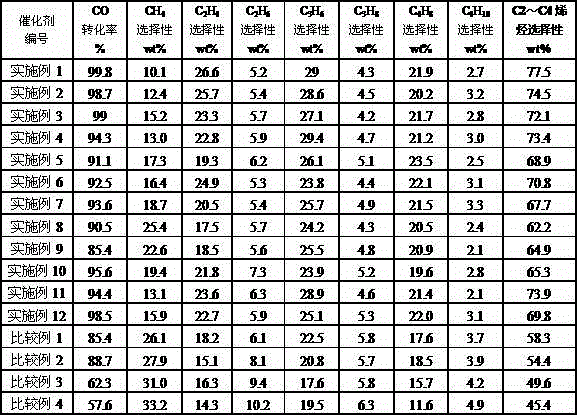Iron catalyst for preparing light olefins by use of synthesis gas and preparation method of iron catalyst
A technology of carbon olefin iron and low-carbon olefins, which is applied in the field of synthesis gas to low-carbon olefin iron catalysts and its preparation, can solve the problems of low selectivity of low-carbon olefins and low CO conversion rate, and achieve improved selectivity and thermal stability Good sex and stable effect
- Summary
- Abstract
- Description
- Claims
- Application Information
AI Technical Summary
Problems solved by technology
Method used
Image
Examples
Embodiment 1
[0028] Weigh 55.0 grams of iron oxide (Fe 2 o 3 ), 16.0 grams of titanium oxide (TiO 2 ), 16.0 grams of molybdenum oxide (MoO 3 ), 5.0 grams of vanadium pentoxide (V 2 o 5 ), 5.0 grams of lanthanum oxide (La 2 o 3 ) and 3.0 g tin oxide (SnO 2 ) Six kinds of raw materials and 3 grams of carbon black powder with a weight percentage of 3% by weight of the total amount of raw materials were mixed in a ball mill for 2 hours; The kneaded material is kneaded until soft; the kneaded material is sent into the extruder, made into a strip with a diameter of 5mm, and cut into a column with a length of 20mm. After natural drying, it is sent to the drying equipment , dried at 120°C for 8 hours for later use; the dried precursor was sent into a high-temperature furnace, calcined at 1400°C for 6.0 hours, and after cooling, it was crushed and sieved into 60-80 meshes to obtain the required high-temperature sintered iron catalyst. The prepared catalyst comprises the following components...
Embodiment 2
[0031] Weigh 88.0 grams of iron oxide (Fe 2 o 3 ), 5.79 grams of titanium oxide (TiO 2 ), 5.79 grams of molybdenum oxide (MoO 3 ), 0.06 g vanadium pentoxide (V 2 o 5 ), 0.06 g lanthanum oxide (La 2 o 3 ) and 0.3 g tin oxide (SnO 2 ) Six kinds of raw materials and 3 grams of carbon black powder with a weight percentage of 3% by weight of the total amount of raw materials were mixed in a ball mill for 2 hours; The kneaded material is kneaded until soft; the kneaded material is sent into the extruder, made into a strip with a diameter of 5mm, and cut into a column with a length of 20mm. After natural drying, it is sent to the drying equipment , dried at 120°C for 8 hours for later use; the dried precursor was sent into a high-temperature furnace, calcined at 1400°C for 6.0 hours, and after cooling, it was crushed and sieved into 60-80 meshes to obtain the required high-temperature sintered iron catalyst. The prepared catalyst comprises the following components in weight p...
Embodiment 3
[0034] Weigh 29.2 grams of iron oxide (Fe 2 o 3 ), 12.5 grams of titanium oxide (TiO 2 ), 12.5 grams of molybdenum oxide (MoO 3 ), 18.0 grams of vanadium pentoxide (V 2 o 5 ), 18.0 grams of lanthanum oxide (La 2 o 3 ) and 9.8 g tin oxide (SnO 2 ) Six kinds of raw materials and 3 grams of carbon black powder with a weight percentage of 3% by weight of the total amount of raw materials were mixed in a ball mill for 2 hours; The kneaded material is kneaded until soft; the kneaded material is sent into the extruder, made into a strip with a diameter of 5mm, and cut into a column with a length of 20mm. After natural drying, it is sent to the drying equipment , dried at 120°C for 8 hours for later use; the dried precursor was sent into a high-temperature furnace, calcined at 1400°C for 6.0 hours, and after cooling, it was crushed and sieved into 60-80 meshes to obtain the desired high-temperature sintered catalyst. The prepared catalyst comprises the following components in ...
PUM
 Login to View More
Login to View More Abstract
Description
Claims
Application Information
 Login to View More
Login to View More - R&D
- Intellectual Property
- Life Sciences
- Materials
- Tech Scout
- Unparalleled Data Quality
- Higher Quality Content
- 60% Fewer Hallucinations
Browse by: Latest US Patents, China's latest patents, Technical Efficacy Thesaurus, Application Domain, Technology Topic, Popular Technical Reports.
© 2025 PatSnap. All rights reserved.Legal|Privacy policy|Modern Slavery Act Transparency Statement|Sitemap|About US| Contact US: help@patsnap.com


